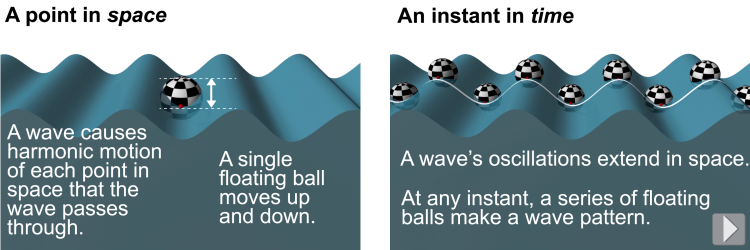|
Oscillations have cycles and so do waves. Waves spread out and move, so their cycles extend over both time and space. Consider a water wave on the surface of a pond. If you watch one single location in space as time goes by, the water oscillates up and down at the frequency of the wave. A ball floating at this location oscillates up and down over time. Next, consider freezing the entire surface of the pond at a single instant of time. In the frozen surface there is also an up–down repeating pattern that repeats in space. 
|

|
At any moment of time, the cycles of a single wave are described by its wavelength. The wavelength is the spatial length of one complete cycle of the wave at one instant of time. Wavelength is a new property of waves that does not exist for a stationary oscillator such as a pendulum. 
|
If you could “freeze” a wave in place, you could measure the wavelength as the distance between two successive crests (or peaks) of the wave. Alternatively, wavelength can be described as the distance between two successive troughs (or lowest points) of the wave. 
|
The frequency of a wave is just like the frequency of an oscillator. A wave with a frequency of 10 Hz repeats itself 10 times per second at every place in space the wave reaches. This allows waves to carry information over great distances. When you listen to a guitar, the sound wave carries information about the vibration of the string from the instrument to your ear. A light wave carries information about color and space to your eyes. Electrical waves in wires and light waves in optical fiber cables carry Internet and television information. A microwave carries cellphone conversations. In nature and in human technology, waves carry energy and information from one place to another. The information could be sound, color, pictures, commands, or virtually anything else. 
|
The amplitude of a water wave is the maximum amount the wave causes the water to rise (or fall) compared to its average resting level. While the amplitude of a water wave is measured as a height in meters, the amplitudes of other waves may have different units. For example, a sound wave is a pressure oscillation and therefore its amplitude is measured in force per unit area, not distance. Most waves become smaller with increasing distance from the source, just as ripples decrease far from the splash of a pebble. Even though the amplitude of the wave decreases, the frequency remains the same. 
|
|
Sound and water waves are mechanical waves, which means that they propagate via the oscillation of matter in a medium. The medium can be a solid, liquid, or gas. As you will learn in Chapter 22, light is an electromagnetic wave that can propagate in a vacuum—without any medium whatsoever.
|
If the amplitude of a water wave is 25 cm, what is the distance between the highest and lowest places in the water surface? - 12.5 cm
- 25 cm
- 50 cm
 |
The correct answer is c because the amplitude is the distance the water surface rises above or falls below its average resting level. If the amplitude is 25 cm then the highest point is 25 cm above the average and the lowest point is 25 cm below the average. This makes the difference between the highest and lowest places to be 50 cm. 
|
What property of waves does not change with distance, damping, or when moving through different materials? - frequency
- wavelength
- amplitude
- velocity
 |
The answer is a, frequency. Frequency is constant for a wave, even if wavelength, amplitude, and speed change. 
|

